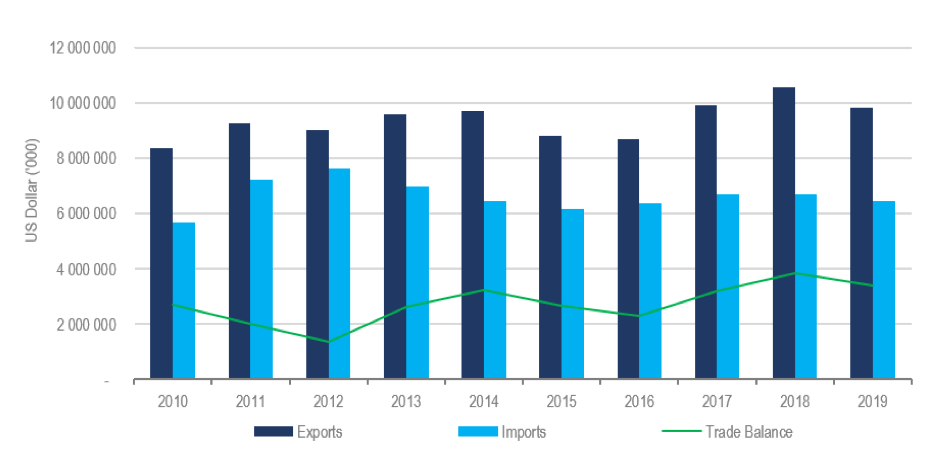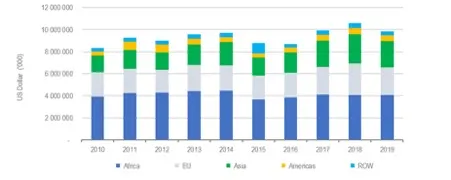After reaching a record level of $10.6-billion in 2018, South Africa’s agricultural exports fell by 8% year-on-year (y/y) in 2019 to $9.8-billion. This, however, was unsurprising as agricultural production data for 2019 showed a notable decline in a number of exportable commodities because of the drought.
The temporary ban on exports of livestock products and wool in 2019, following the outbreak of foot-and-mouth disease at the start of the year, also contributed to the decline in exports. Be that as it may, the top exportable agricultural products for 2019 included citrus, wine, grapes, apples and pears, sugar, macadamia nuts, wool and maize.
Over the same period, South Africa’s agricultural products imports declined by 4% y/y to $6.4-billion. This was underpinned by the decline in the import value of rice, meat, wheat and palm oil. But these products remained among the top imported agricultural products in value terms. Overall, this subsequently led to a 12% y/y decline in South Africa’s agricultural trade surplus to $3.4-billion, as shown in Exhibit 1 below.
South Africa’s agricultural trade

Source: Trade Map, Agbiz Research
From a destination point of view, the African continent and Europe continued to be the largest markets for South Africa’s agricultural exports, respectively absorbing 41% and 26% of total exports in 2019, measured in value terms. The leading products to these markets were beverages, fruit, vegetables, sugar, wool and grains.
Asia is also an important market for South Africa’s agricultural exports, demanding a 24% export share in 2019. Wool, fruit, grains, beverages, vegetables and meat were the leading products exported to this region. The Americas and the rest of the world (ROW) accounted for 5% and 4% shares, as shown in Exhibit 2 below. Exports to these regions were also dominated by fruits, beverages, vegetables, sugar and grains.
South Africa’s agricultural exports by region

ROW represents the Rest of the World. (Source: Trade Map, Agbiz Research)
Looking ahead
South Africa’s agricultural exports could recover somewhat in 2020. The improved weather conditions have led to an increase in summer crops’ area plantings and prospects of a bigger maize harvest, which is an exportable commodity. The South African wine grapes production is also set to increase in 2020, thus contributing to a larger wine volume output.
There is also general optimism about the 2020 harvest in the fruit industry, which supports our view of possible improvement in agriculture exports. The industry that is still on the back foot because of biosecurity concerns is the red meat sector. There is currently a ban on South Africa’s livestock products (including red meat) exports because of the foot-and-mouth disease outbreak that occurred towards the end of 2019.
Policy considerations
The South African government and private sector players have embraced a vision of expanding labour-intensive agricultural sub-sectors as part of a broader development strategy. This is to be an export-driven initiative. Such sub-sectors are mainly horticulture and to a certain extent, field crops.
Fortunately, the top-value agricultural exports over the past five years were also within these sub-sectors, which means that South Africa is on the right path in its agricultural development strategy.
With that said, while a 24% share of South Africa’s agricultural exports goes to Asia, as previously noted, there is still potential to expand participation in that market. With India and China headlining the growth potential in Asia and the Far East, this region overall is significant enough to warrant more attention, especially given that there is currently no preferential market access for South Africa’s agricultural sector in this region.
South Africa is having to compete with the likes of Australia and Chile, which have secured trade agreements that have afforded them a significant competitive advantage which could end up threatening South Africa’s market share and future growth. Therefore, South Africa should continue to engage these countries for greater market access to agricultural products. BM














 Become an Insider
Become an Insider